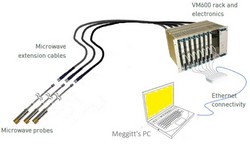Development of an improved Microwave Clearance Measurement System
Among the many integrated technology demonstrators (ITDs), the Sustainable and Green Engine (SAGE) ITD targets engine technologies that reduce fuel consumption and associated emissions. The geared turbofan is expected to reduce fuel consumption and carbon dioxide emissions by 15 % and perceived noise levels by 50 % in comparison with turbofan engines currently in use. These reductions are in line with Clean Sky's commitment to reach the targets set out by the Advisory Council for Aviation Research and Innovation in Europe (ACARE) for 2020. One of the major challenges of gas turbine configurations has been the clearance between the blade tips and the surrounding casing (shrouds) that tends to vary because of changes in the mechanical and thermal loads on the rotating and stationary structures. Experimental activities so far have failed to distinguish between radial and axial clearance, resulting in inaccurate clearance measurements. Work conducted in the MICMEST (Microwave clearance measurement system for low pressure turbines) project addressed this concern by further advancing the technology readiness level of the microwave clearance measurement system (MCMS). The aim of MICMEST was to validate the improved MCMS in the geared turbofan incorporating the latest low-pressure turbine technology, proving that it is able to operate in and survive the harsh high-temperature environment. The MCMS – comprising a probe, data acquisition hardware and data processing software – should eventually become part of a closed-loop active clearance system that has to maintain adequate tip clearance at all operating points. Researchers proceeded with their objectives through designing and testing new blade shrouds with specific rib geometries providing an excitation signal that enable the measurement off axial and radial rotor positions. The project led to the following major accomplishments: new blade shrouds including geometric features providing a signal over a large range of axial position and radial clearance, a new spin rig was designed and built for the laboratory validation of the measurement system before installation in the engine. A sensor installation concept that meets SAGE4 Demonstrator Engine mounting requirements and containment constraints was designed and validated. The durability of the microwave sensors was demonstrated through a comprehensive laboratory temperature test campaign. The MCMS went through the SAGE4 engine test campaign and proved able to record measurements data with no sensor failures. Although researchers successfully recorded measurement data with no sensor failures, further work needs to be carried out to mature the MCMS technology to achieve the ultimate objective of integrating the system for series applications in an Active Clearance Control (AAC) system.







